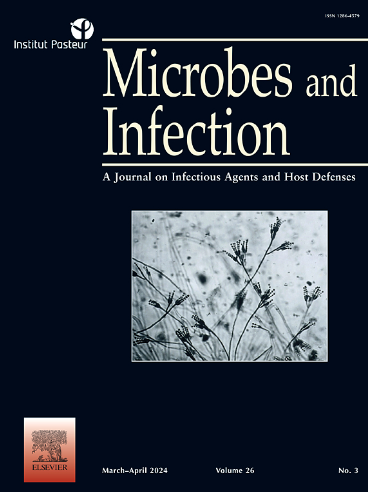HERV-W ENV transcription in B cells predicting symptomatic COVID-19 and risk for long COVID can express a full-length protein despite stop codon in mRNA from chromosome X via a ribosome readthrough
IF 2.7
4区 医学
Q3 IMMUNOLOGY
引用次数: 0
Abstract
The human genome comprises 8 % of endogenous retroviruses (HERVs). Though HERVS contribute to physiological functions, copies retained pathogenic potential. The HERV-W ENV protein was shown expressed in patients with worse COVID-19 symptoms and post-COVID syndrome. A significant detection of the mRNA encoding HERV-W ENV from patients with COVID-19 in B cells from RNAseq reads obtained from peripheral blond mononuclear cells. This data stratified with increased COVID-19 symptoms or with post-acute sequelae of COVID-19 (long COVID) after 3 months. The HERV-W ENV-U3R RNA was confirmed to display the best alignment with chromosome X ERVWE2 locus. However, a stop codon precluding its translation was re-addressed after recent understandings of ribosome readthrough mechanisms. Experimental results evidenced that this HERV gene can effectively express a full-length protein in the presence of molecules allowing translation via a readthrough mechanism at the ribosome level. Results not only confirm HERV-W ENV RNA origin in these patients but show for the first time how a defective HERV copy can be translated into a complete protein when specific factors make it possible at the ribosome level. The present proof of concept now requires further studies to identify the factors involved in this newly understood mechanism, following SARS-CoV-2 exposure.
HERV-W ENV 在 B 细胞中的转录可预测有症状的 COVID-19 和长 COVID 风险,尽管来自 X 染色体的 mRNA 中存在终止密码子,但 HERV-W ENV 仍可通过核糖体通读表达全长蛋白质。
人类基因组中有 8%的内源性逆转录病毒(HERVs)。虽然 HERVS 有助于生理功能,但其拷贝仍具有致病潜力。在 COVID-19 症状加重和后 COVID 综合征患者中,HERV-W ENV 蛋白得到了表达。从外周金黄色单核细胞中获得的 RNAseq 读取结果显示,在 COVID-19 患者的 B 细胞中发现了编码 HERV-W ENV 的 mRNA。该数据与 COVID-19 症状加重或 3 个月后 COVID-19 急性后遗症(长 COVID)分层。经证实,HERV-W ENV-U3R RNA 与 X 染色体 ERVWE2 基因座的比对结果最佳。然而,在最近对核糖体通读机制的了解之后,重新解决了阻碍其翻译的终止密码子问题。实验结果表明,该 HERV 基因在有允许通过核糖体水平的读穿机制进行翻译的分子存在时,可有效表达全长蛋白质。实验结果不仅证实了这些患者体内 HERV-W ENV RNA 的来源,而且首次展示了当特定因素在核糖体水平使翻译成为可能时,有缺陷的 HERV 拷贝如何翻译成完整的蛋白质。现在需要对目前的概念证明进行进一步研究,以确定在接触 SARS-CoV-2 病毒后,参与这种新认识机制的因素。
本文章由计算机程序翻译,如有差异,请以英文原文为准。
求助全文
约1分钟内获得全文
求助全文
来源期刊

Microbes and Infection
医学-病毒学
CiteScore
12.60
自引率
1.70%
发文量
90
审稿时长
40 days
期刊介绍:
Microbes and Infection publishes 10 peer-reviewed issues per year in all fields of infection and immunity, covering the different levels of host-microbe interactions, and in particular:
the molecular biology and cell biology of the crosstalk between hosts (human and model organisms) and microbes (viruses, bacteria, parasites and fungi), including molecular virulence and evasion mechanisms.
the immune response to infection, including pathogenesis and host susceptibility.
emerging human infectious diseases.
systems immunology.
molecular epidemiology/genetics of host pathogen interactions.
microbiota and host "interactions".
vaccine development, including novel strategies and adjuvants.
Clinical studies, accounts of clinical trials and biomarker studies in infectious diseases are within the scope of the journal.
Microbes and Infection publishes articles on human pathogens or pathogens of model systems. However, articles on other microbes can be published if they contribute to our understanding of basic mechanisms of host-pathogen interactions. Purely descriptive and preliminary studies are discouraged.
 求助内容:
求助内容: 应助结果提醒方式:
应助结果提醒方式:


